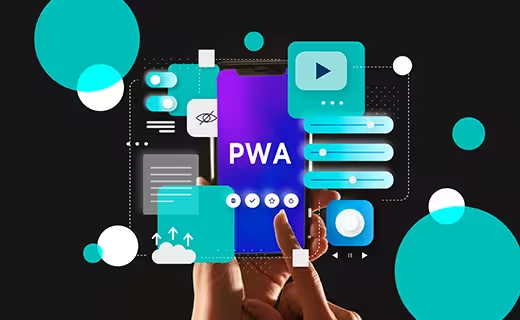
We all know that smartphone users are increasing drastically, hence the expectations with the responsiveness too! The number of smartphone subscriptions worldwide today surpasses six billion and is forecast to grow by several hundred million in the next few years. With the consequence of Covid, e-commerce is correspondingly evolving. Merchants are welcoming new technologies to stay ahead of their competitors. To win this rat race of e-commerce, retailers are going headless. Yes, you read it right!
Being headless means having speed and consistency! PWA- Progressive Web Application, per se, is all about reacting to such circumstances. Many firms have established stores and websites using such technology. This post is all about what PWA means and how it contributes to e-commerce. Let’s dig deep!
Table of Contents
What is PWA?
Progressive Web Application provides Web accessibility like browsers and acts like Native apps. It runs on any platform that follows standard web compliance for desktop and mobile. To aid you to understand easily, PWA is a mixture of Websites and Native apps that provides lightning-fast speed with user reach data and experience, even in low internet connectivity.
So when you think of PWA, think Fresh, Fast, Responsive, Safe, App-like web experience.
Why is it essential to adopt PWA in e-commerce?
The apparent reason for adopting new enhanced technology is to put you ahead of your competitors. As said, smartphone users are increasing, so shopping tends to be done through the devices the users are more active. Isn’t it? On the flip side, mobile has specific limitations to drift the similar shopping experience like desktops. The one is RWD- Responsive Web Design. Yes, RWD fits the size of the desk to the mobile and is not that user-friendly. It utilizes the same code from the desk to mobile, and hence, the load time increases if the internet is poor.
Moving on to the Native applications, it’s tedious to go to the play/app stores, see the applications, download them, use them, and update them on time. A noticeable amount of cellular data is used while doing all the needy actions for Native apps. Not only this, but in the background, the apps need to be synced, and hence the applications run all the time, and the data is used. For Merchants, it is expensive to craft the applications and no guarantee for acceptance in the marketplace.
Consumers are turning to mobile in undeniable numbers, but conversions and revenue are dragging. Consumers are starving for an app-like experience transcending the limitations of native apps. PWA is the key to solving the issues of Mobile browsers and Native apps. It is a pretty new technology and making its way into the last few years.
PWA works in the poor network, allows push notifications, doesn’t require timely updates like apps, and is super fast! Let’s find out the benefits for vendors and customers for using such technology.
What are the advantages for Users and Vendors?
PWA provides the best web browsers and native app functionalities to enhance mobile commerce. It improves user engagement, increases conversion rate, and hence the revenue growth.
Not only merchants but consumers are benefited from such upgrades. Listed are some godsends for merchants and users. Firstly, let’s see how it will aid e-shop owners.
How is PWA profitable to shop owners?
-
Broad Reach: PWA web stores can be worked as a website across any platform using any web browser. It can be downloaded on mobile devices or used in mobile browsers, allowing it to have a broad reach in the market. So, it will aid in marketing tactics in a generalized format, not being specified for mobile or desk. Fewer efforts!
-
Reduced cost and time: PWA allows developing and delivering core web vitals across all the platforms within a single code! It means merchants have a single code that all can access and update spontaneously. There is no need to do the updates and changes for each device, and hence it reduces the time of development, deployment, and maintenance cost-effectively.
-
Lightning-fast speed: Being web-based, PWAs are lightweights compared to Native apps and allow easy access and sharing. With a smaller caching mechanism, it provides super-fast speeds.
-
Increased Conversions: PWA-powered stores have increased conversions by having engaging designs and enhanced user experience with swift and smooth transactions. It allows working in low internet bandwidth. On top of that, it facilitates merchants with push notifications. I mean, wow!
-
One For all and all for one: Previously, UI/UX had to be done comparing mobile and desk. PWAs allow developers to craft the same code that fits all the devices and work with any browser. Retailers have to develop a code once, and it has a property to covert it in any accordance.
-
Security: Payment is vital and should be safe for e-commerce. PWA allows easy integration with payment APIs and permits quick purchases in seconds with no form fills.
-
Better SEO and Google ranking: PWA was first introduced by Steve jobs and then developed by the Google dev team. In the last few years, Google has been counting on how quickly the page loads and is adopted by any device for SEO, followed by some core web vitals. Being PWA fulfills the requirements for such core web vitals and, hence, better SEO!
-
Reduced timely maintenance cost: PWA has a property to convert the code that fits any device, be it a web or app. Building an App and having convenient maintenance, let’s say twice for android and iOS, needs a higher budget. With the efficiency of having one app for all the devices with coherent experience, PWA also cuts down the maintenance cost.
If PWA allows merchants with such benefits and not for the users, it does not make any sense! Let’s find how it has counted blessings to users.
How is PWA profitable to users?
-
Consistency: Often, if the mobile-first approach or RWD is not made correctly, there’s a vast difference between shopping through desk and mobile. PWA provides consistency for all the devices, be it a desk or mobile. If the user left the cart page on the desk and wants to complete the purchase via smartphone, it feels the same store as a desk and allows easy navigation till the purchase.
-
Lower data requirements: It can run in lower internet bandwidth by being smaller and having a trimmer caching mechanism. PWAs can also allow users to utilize the stores in offline mode too.
-
App-like but super fast: Lesser size allows PWA-powered stores/apps to download updates swiftly, even in poor networks. Behaving an App like and aiding the same features, there’s no need to have timely upgrades or sign-ups.
-
Better CX: With a sharp shift in mobile commerce these days, merchants aim to have the same desktop-like UX for the customers. PWA allows crafting the same enhanced user journey as apps with a better customer experience.
Looking at this bundle of benefits listed above, no wonder industry is putting weight on such technologies to get explored and deployed. One might think about how it can work when retailers wish to shift to PWAs? Bit by bit, on the go, or what? Below is your answer.
When is the best time to implement it, and how to move forward with it?
As e-commerce is evolving and the latest trends like Omnichannel experience, personalization, and latest technologies like AR-VR are a part of e-commerce, now is the time one should think of being headless! Why do we use headless! Merchants can have storefront and backend separated by each other and connected through a medium of APIs. PWA is a technology where merchants can develop a distinct storefront that works with any backend technology. Let’s not go into details of being headless and see how one can deploy PWA. We can cover this subject in subsequent articles, or you can reach out to our experts.
There’s a process of deploying PWAs.
-
It can be having a piece by piece changing the storefront, allowing testing with specific users, and likewise moving gradually.
-
The other option is to change the entire storefronts on the go—this requires a reasonable amount of effort, time, and testing. On top of that, users need to accept the new storefronts.
-
The last one is to do it from scratch! It takes months or a year to craft the storefronts, backend, and sync them with commands of APIs. Everything should be done with proper planning, standard process, and rigorous efforts. This approach is used when the brands have time and funding to expand!
Ultimately, the shop owners have the decision to be made! How quickly and smartly they want to move boldly. There’s “N” number of things available in the market to speed up the process! It can be Magento PWA studio, Hyva Themes, Vue-store fronts, and so on. Choose your technical partner wisely for such updates!
Summary
In short, businesses are adopting PWAs and welcoming new technologies. One should not wait to explore it and start amending the stores bit by bit. It will surely aid retailers to grow strongly by reaching more shoppers across the globe. Business owners should start implementing it and see the additional features that enhance the customer journey.

